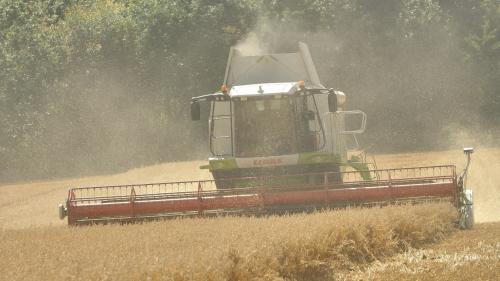Mycotoxins are naturally occurring toxins produced by fungal infection of agricultural crops. Several hundred mycotoxins have been characterized in a wide range of food crops around the world, and new mycotoxins and mycotoxin metabolites are continuously discovered. Mycotoxins can cause adverse health effects in humans including cancer, gastrointestinal disturbances or suppression of the immune system.
In a bid to prevent or reduce mycotoxin contamination in cereals, and in collaboration with growers and processors, we have conducted a farm survey to assess mycotoxin levels in oats grown across Scotland. Through our research we have identified low-intensity cereal rotations and organic production as potential mitigation strategies for Scottish oat growers.

Stage
Directory of Expertise
Purpose
In the UK, mycotoxins produced by Fusarium fungi on cereals such as wheat, oat and barley pose the main problem. The toxicity of several Fusarium mycotoxins is well recognized and maximum permitted levels in cereals have been established by the European Commission to minimize exposure risk.
At the University of Aberdeen's Rowett Institute, previous work demonstrated that dietary exposure to Fusarium mycotoxins is frequent in Scottish adults and children, and that high exposure (above safe levels) can happen (Gratz 2014, Gratz 2020). We also highlighted that in addition to fungal mycotoxins, the cereal plant converts mycotoxins to masked mycotoxins, which will contribute to human dietary exposure (Gratz 2017, Daud 2020 a and b).
Through liaising with Food Standards Scotland and Food Standards Agency, we have focused our current program of work on assessing mycotoxin contamination across the cereal supply chain from primary agricultural production through storage and processing.
This project has two main aims:
1. To support the cereal industry by identifying solutions and mitigation strategies to prevent or reduce mycotoxin contamination in cereals and inform industry testing.
2. To quantify the occurrence of mycotoxins in Scottish grown cereals and provide data to inform the Food Standard Agency’s Risk Analysis process.
This work is carried out in collaboration with industry partners and other SEFARI research institutes.
Results
In collaboration with the cereal industry and the Scottish Organic Producers Association we have assessed (Gratz, 2023) the main drivers of mycotoixn contamination in Scottish grown oats to identify potential mitigation strategies.
We analysed samples from 33 farms across Scotland and collected additional sample information via questionnaire. The study shows that less cereal crops within a crop rotation (i.e. low cereal intensity) can reduce the risk for high levels of T-2 and HT-2 toxins, known to impair protein and DNA synthesis and the most commonly detected Fusarium mycotoxins in oats. We have also found that organic oats contain lower levels of the mycotoxins compared to conventional oats. This work has been presented at the 14th World Mycotoxin Forum in October 2023: Session: Managing and Mitigating Mycotoxin Risks.
During the next stage of this project, we will assess mycotoxin levels in cereals from conventional and organically managed field trials run at Scottish Rural University College’s (SRUC) Aberdeenshire Cropping Experimental (ACE) Platform to look for further mitigation strategies.
While working with our partners in the cereal industry we also assessed some frequently used rapid test kits for mycotoxin detection on site. These kits were assessed for their ability to accurately detect free mycotoxins (e.g. T-2 and HT-2) and masked mycotoxins. We found that all kits detected free mycotoxins and also detected masked forms of mycotoxins, although at varying levels. This information has been shared with industry stakeholders to assist their interpretation of testing results and decision making.
Benefits
Our findings are being generated in collaboration with industry and policy makers to ensure the production of safe, high-quality food. The research is important in protecting consumers from high exposure to mycotoxins.
Industry impact
To support growers, our work has identified low-cereal intensity rotations and organic production as potential mitigation strategies that can significantly lower mycotoxin levels in oats. These two agronomic practices can be implemented at farm level and offer real world solutions to minimise the risk of mycotoxin contamination in oats.
To support processors our work has evaluated rapid test kits and found cross-reactivity with masked mycotoxins which will better inform decision making on site during cereal processing.
Policy impact
Evidence from this study on the occurrence of T-2/HT-2 toxins in oats has been submitted to the Food Standards Agency (FSA) to directly inform their current risk analysis process. Outputs inform any future risk management advice for these important mycotoxins, including possible risk management options, will be presented to Ministers.
Project Partners
Scottish Organic Producers Association (SOPA), Hamlyns of Scotland, WN Lindsay, Funding: SG RESAS, Interface Multiparty Fund.